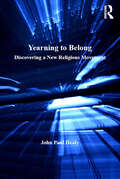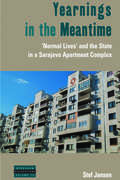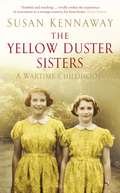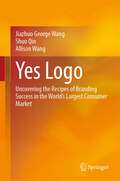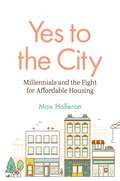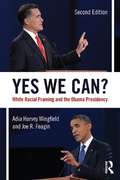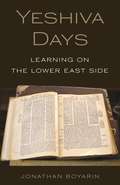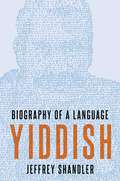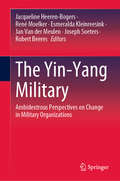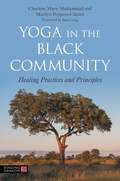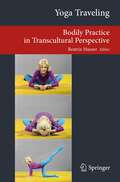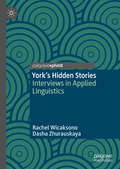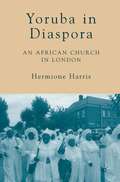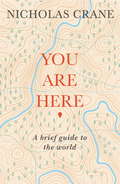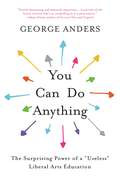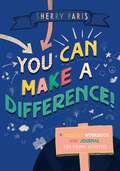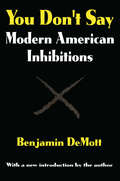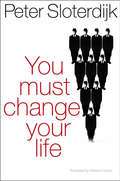- Table View
- List View
Yearning to Belong: Discovering a New Religious Movement (Routledge New Religions)
by John Paul HealyCutting across three areas of interest within New Religious Movements - insider perspectives, sociology of religion and the helping professions - this book explores insiders' experience of the Indian Guru-disciple Yogic tradition and is authored by a former member of that tradition. Highlighting the rich spiritual experience of devotees of Guru-disciple Yoga, and broadening the understanding of Guru-disciple Yoga Practice, this book also adds considerably to knowledge of conversion to New Religious Movements and to issues of affiliation and disengagement. Exploring participants' experience of attraction, affiliation and disengagement, these themes highlight individuals' personal experience of Guru-disciple Yoga Practice.
Yearnings in the Meantime: 'Normal Lives' and the State in a Sarajevo Apartment Complex (Dislocations #15)
by Stef JansenShortly after the book’s protagonists moved into their apartment complex in Sarajevo, they, like many others, were overcome by the 1992-1995 war and the disintegration of socialist Yugoslavia More than a decade later, in post-war Bosnia and Herzegovina, they felt they were collectively stuck in a time warp where nothing seemed to be as it should be. Starting from everyday concerns, this book paints a compassionate yet critical portrait of people’s sense that they were in limbo, trapped in a seemingly endless “Meantime.” Ethnographically investigating yearnings for “normal lives” in the European semi-periphery, it proposes fresh analytical tools to explore how the time and place in which we are caught shape our hopes and fears.
The Yellow Duster Sisters: A Wartime Childhood
by Susan Kennaway1939. Nine year old Susie and her sister Gyll live in Watford, and all week look forward to their Saturday shopping expedition to Woolworths with their nanny, to buy something nice for Mummy. But as war breaks out in Europe, the girls are evacuated to Africa. Feeling abandoned and alone, the sisters find their new life miserable and get no sympathy from their guardians, who force them to wear patched-up clothes and be in bed by six o'clock. As time passes and letters from home stop arriving, the sisters dream of escape and of returning to idyllic England. Yet when they finally do arrive home, all the changes that await them make for a very different life than the one they had longed for... Intensely funny and charming, Susan Kennaway writes about growing up during the Second World War with rare honesty and insight.
Yes Logo: Uncovering the Recipes of Branding Success in the World’s Largest Consumer Market
by Jiazhuo George Wang Shuo Qin Allison WangThis book focuses on how to succeed in China, the globe’s largest consumer market, through the branding market strategy. What are the undisclosed recipes that brands can follow to capture the attention and emotion of consumers in China? What’s the magical key to open the locked doors? The answer to these questions would be intriguing for many readers outside China, including but not limited to executives of global brands, owners of medium-and-small-sized businesses aiming for the global market, branding/marketing professionals, financial investors and analysts, business professors and researchers in universities and colleges, graduate and undergraduate students, and readers with an interest on these topics in the general public.In comparison with many case studies that focus on only a single or few cases, or else lean toward being a macro-discussions of China’s consumer market without in-depth analysis of representative cases, this book provides both. Many branding strategies, programs, and activities presented in this book are of the innovative type, which could be very fresh and interesting to readers. Many of the in-depth analyses and specific insights presented in this book are provided by well-recognized business analysts/writers, which may not be available in other publications. Overall, this book provides readers with the opportunity to receive some valuable new knowledge about how to succeed in the globe’s largest consumer market, providing foodstuff for both thought and enjoyment.
Yes to the City: Millennials and the Fight for Affordable Housing
by Max HolleranA fascinating account of the growing "Yes in My Backyard" urban movement The exorbitant costs of urban housing and the widening gap in income inequality are fueling a combative new movement in cities around the world. A growing number of influential activists aren&’t waiting for new public housing to be built. Instead, they&’re calling for more construction and denser cities in order to increase affordability. Yes to the City offers an in-depth look at the &“Yes in My Backyard&” (YIMBY) movement. From its origins in San Francisco to its current cadre of activists pushing for new apartment towers in places like Boulder, Austin, and London, Max Holleran explores how urban density, once maligned for its association with overpopulated slums, has become a rallying cry for millennial activists locked out of housing markets and unable to pay high rents.Holleran provides a detailed account of YIMBY activists campaigning for construction, new zoning rules, better public transit, and even candidates for local and state office. YIMBY groups draw together an unlikely coalition, from developers and real estate agents to environmentalists, and Holleran looks at the increasingly contentious battles between market-driven pragmatists and rent-control idealists. Arguing that advocates for more housing must carefully weigh their demands for supply with the continuing damage of gentrification, he shows that these individuals see high-density urbanism and walkable urban spaces as progressive statements about the kind of society they would like to create.Chronicling a major shift in housing activism during the past twenty years, Yes to the City considers how one movement has reframed conversations about urban growth.
Yes We Can?: White Racial Framing and the Obama Presidency
by Adia Harvey-Wingfield Joe FeaginThe first edition of this book offered one of the first social science analyses of Barack Obama’s historic electoral campaigns and early presidency. In this second edition the authors extend that analysis to Obama’s service in the presidency and to his second campaign to hold that presidency. Elaborating on the concept of the white racial frame, Harvey Wingfield and Feagin assess in detail the ways white racial framing was deployed by the principal characters in the electoral campaigns and during Obama’s presidency. With much relevant data, this book counters many commonsense assumptions about U.S. racial matters, politics, and institutions, particularly the notion that Obama’s presidency ushered in a major post-racial era. Readers will find this fully revised and updated book distinctively valuable because it relies on sound social science analysis to assess numerous events and aspects of this historic campaign.
Yes We Can?: White Racial Framing and the Obama Presidency
by Adia Harvey-Wingfield Joe FeaginThe first edition of this book offered one of the first social science analyses of Barack Obama’s historic electoral campaigns and early presidency. In this second edition the authors extend that analysis to Obama’s service in the presidency and to his second campaign to hold that presidency. Elaborating on the concept of the white racial frame, Harvey Wingfield and Feagin assess in detail the ways white racial framing was deployed by the principal characters in the electoral campaigns and during Obama’s presidency. With much relevant data, this book counters many commonsense assumptions about U.S. racial matters, politics, and institutions, particularly the notion that Obama’s presidency ushered in a major post-racial era. Readers will find this fully revised and updated book distinctively valuable because it relies on sound social science analysis to assess numerous events and aspects of this historic campaign.
Yeshiva Days: Learning on the Lower East Side
by Jonathan BoyarinAn intimate and moving portrait of daily life in New York's oldest institution of traditional rabbinic learningNew York City's Lower East Side has witnessed a severe decline in its Jewish population in recent decades, yet every morning in the big room of the city's oldest yeshiva, students still gather to study the Talmud beneath the great arched windows facing out onto East Broadway. Yeshiva Days is Jonathan Boyarin's uniquely personal account of the year he spent as both student and observer at Mesivtha Tifereth Jerusalem, and a poignant chronicle of a side of Jewish life that outsiders rarely see.Boyarin explores the yeshiva's relationship with the neighborhood, the city, and Jewish and American culture more broadly, and brings vividly to life its routines, rituals, and rhythms. He describes the compelling and often colorful personalities he encounters each day, and introduces readers to the Rosh Yeshiva, or Rebbi, the moral and intellectual head of the yeshiva. Boyarin reflects on the tantalizing meanings of "study for its own sake" in the intellectually vibrant world of traditional rabbinic learning, and records his fellow students' responses to his negotiation of the daily complexities of yeshiva life while he also conducts anthropological fieldwork.A richly mature work by a writer of uncommon insight, wit, and honesty, Yeshiva Days is the story of a place on the Lower East Side with its own distinctive heritage and character, a meditation on the enduring power of Jewish tradition and learning, and a record of a different way of engaging with time and otherness.
Yeshiva Days: Learning on the Lower East Side
by Jonathan BoyarinAn intimate and moving portrait of daily life in New York's oldest institution of traditional rabbinic learningNew York City's Lower East Side has witnessed a severe decline in its Jewish population in recent decades, yet every morning in the big room of the city's oldest yeshiva, students still gather to study the Talmud beneath the great arched windows facing out onto East Broadway. Yeshiva Days is Jonathan Boyarin's uniquely personal account of the year he spent as both student and observer at Mesivtha Tifereth Jerusalem, and a poignant chronicle of a side of Jewish life that outsiders rarely see.Boyarin explores the yeshiva's relationship with the neighborhood, the city, and Jewish and American culture more broadly, and brings vividly to life its routines, rituals, and rhythms. He describes the compelling and often colorful personalities he encounters each day, and introduces readers to the Rosh Yeshiva, or Rebbi, the moral and intellectual head of the yeshiva. Boyarin reflects on the tantalizing meanings of "study for its own sake" in the intellectually vibrant world of traditional rabbinic learning, and records his fellow students' responses to his negotiation of the daily complexities of yeshiva life while he also conducts anthropological fieldwork.A richly mature work by a writer of uncommon insight, wit, and honesty, Yeshiva Days is the story of a place on the Lower East Side with its own distinctive heritage and character, a meditation on the enduring power of Jewish tradition and learning, and a record of a different way of engaging with time and otherness.
Yiddish: Biography of a Language
by Jeffrey ShandlerThe most widely spoken Jewish language on the eve of the Holocaust, Yiddish continues to play a significant role in Jewish life today, from Hasidim for whom it is a language of daily life to avant-garde performers, political activists, and LGBTQ writers turning to Yiddish for inspiration. Yiddish: Biography of a Language presents the story of this centuries-old language, the defining vernacular of Ashkenazi Jews, from its origins to the present. Jeffrey Shandler tells the multifaceted history of Yiddish in the form of a biographical profile, revealing surprising insights through a series of thematic chapters. He addresses key aspects of Yiddish as the language of a diasporic population, whose speakers have always used more than one language. As the vernacular of a marginalized minority, Yiddish has often been held in low regard compared to other languages, and its legitimacy as a language has been questioned. But some devoted Yiddish speakers have championed the language as embodying the essence of Jewish culture and a defining feature of a Jewish national identity. Despite predictions of the demise of Yiddish-dating back well before half of its speakers were murdered during the Holocaust-the language leads a vibrant, evolving life to this day.
Yiddish: Biography of a Language
by Jeffrey ShandlerThe most widely spoken Jewish language on the eve of the Holocaust, Yiddish continues to play a significant role in Jewish life today, from Hasidim for whom it is a language of daily life to avant-garde performers, political activists, and LGBTQ writers turning to Yiddish for inspiration. Yiddish: Biography of a Language presents the story of this centuries-old language, the defining vernacular of Ashkenazi Jews, from its origins to the present. Jeffrey Shandler tells the multifaceted history of Yiddish in the form of a biographical profile, revealing surprising insights through a series of thematic chapters. He addresses key aspects of Yiddish as the language of a diasporic population, whose speakers have always used more than one language. As the vernacular of a marginalized minority, Yiddish has often been held in low regard compared to other languages, and its legitimacy as a language has been questioned. But some devoted Yiddish speakers have championed the language as embodying the essence of Jewish culture and a defining feature of a Jewish national identity. Despite predictions of the demise of Yiddish-dating back well before half of its speakers were murdered during the Holocaust-the language leads a vibrant, evolving life to this day.
The Yin-Yang Military: Ambidextrous Perspectives on Change in Military Organizations
by Jacqueline Heeren-Bogers René Moelker Esmeralda Kleinreesink Jan Van der Meulen Joseph Soeters Robert BeeresThis book examines change processes and the challenge of ambidexterity in military organizations. It discusses how military organizations can better adapt to the complex, and at times chaotic, environments they operate in by developing organizational ambidexterity. The authors identify various multiple tasks and functions of military organizations that require multi-dimensional and often contradictory operational, technological, cultural, and social skills. In analogy to the often-opposed functions performed by the right and left hand of the body, modern military organizations are no longer one-dimensional fighting machines, but characterized by a duality of tasks, such as fighting and peacekeeping which often make part and parcel of one and the same mission. The military is both a “hot” and a “cold” organization (a crisis management organization and a bureaucracy). As such, the book argues that these dualities are not necessarily opposed but can serve as complementary forces, like the yin and yang, to better the overall performance of these organizations. As a consequence, ambidextrous organizations excel at complex tasking and are adaptable to new challenges. Divided into four parts: 1) structures and networks; 2) cultural issues; 3) tasks and roles; 4) nations and allies, it appeals to scholars of military studies and organization studies as well as professionals working for governmental or military organizations.
Yoga in the Black Community: Healing Practices and Principles
by Charlene Marie Muhammad Marilyn Peppers-CitizenAs the practice of yoga continues to flourish within Western Black and Brown communities, this transformative, Black culturally centered toolkit highlights the barriers that hinder access to yoga. It takes core aspects of yoga philosophy and contextualizes it within Black cultural norms, religious taboos, and historical healing practices, and teaches readers how to foster a safe haven for their clients and communities.Based on decades' worth of experience and expertise, this dynamic author duo discusses important topics such as health disparities, complementary healthcare, and the rich heritage and resilience of Black communities. This is an invaluable and practical resource that offers practices and actionable guidance and supports practitioners to explore a Black culturally centered approach to yoga whilst facilitating better health and wellbeing for Black people.
Yoga in the Black Community: Healing Practices and Principles
by Charlene Marie Muhammad Marilyn Peppers-CitizenAs the practice of yoga continues to flourish within Western Black and Brown communities, this transformative, Black culturally centered toolkit highlights the barriers that hinder access to yoga. It takes core aspects of yoga philosophy and contextualizes it within Black cultural norms, religious taboos, and historical healing practices, and teaches readers how to foster a safe haven for their clients and communities.Based on decades' worth of experience and expertise, this dynamic author duo discusses important topics such as health disparities, complementary healthcare, and the rich heritage and resilience of Black communities. This is an invaluable and practical resource that offers practices and actionable guidance and supports practitioners to explore a Black culturally centered approach to yoga whilst facilitating better health and wellbeing for Black people.
Yoga Traveling: Bodily Practice in Transcultural Perspective (Transcultural Research – Heidelberg Studies on Asia and Europe in a Global Context)
by Beatrix HauserThis book focuses on yoga’s transcultural dissemination in the twentieth and twenty-first centuries. In the course of this process, the term “yoga” has been associated with various distinctive blends of mental and physical exercises performed in order to achieve some sort of improvement, whether understood in terms of esotericism, fitness, self-actualization, body aesthetics, or health care. The essays in this volume explore some of the turning points in yoga’s historico-spatial evolution and their relevance to its current appeal. The authors focus on central motivations, sites, and agents in the spread of posture-based yoga as well as on its successive (re-)interpretation and diversification, addressing questions such as: Why has yoga taken its various forms? How do time and place influence its meanings, social roles, and associated experiences? How does the transfer into new settings affect the ways in which yogic practice has been conceptualized as a system, and on what basis is it still identified as (Indian) yoga? The initial section of the volume concentrates on the re-evaluation of yoga in Indian and Western settings in the first half of the twentieth century. The following chapters link global discourses to particular local settings and explore meaning production at the micro-social level, taking Germany as the focal site. The final part of the book focuses on yoga advertising and consumption across national, social, and discursive boundaries, taking a closer look at transnational and deterritorialized yoga markets, as well as at various classes of mobile yoga practitioners.
York's Hidden Stories: Interviews in Applied Linguistics
by Rachel Wicaksono Dasha ZhurauskayaThis book explores the mechanics of storytelling within a study aimed at focusing on a ‘hidden’ population of migrants in the city of York, UK. Taking applied linguistics to mean the consideration of real-world ‘problems’ as identified by a ‘client’, in which the use of (and beliefs about) language is a significant component, the authors describe the benefits and challenges of working in a partnership with a community organisation. With project participants from Africa, Europe, Asia and South and Central America who had lived in York between two and fifty years, the study considers the co-construction of meaning in interviews from a range of practical and theoretical perspectives. The book will be of interest to students, academic researchers and community project leaders who are interested in migration stories and interviews as a method of data collection.
Yoruba in Diaspora: An African Church in London (Contemporary Anthropology of Religion)
by H. HarrisThe Nigerian diaspora is now world-wide, and when Yoruba travel, they take with them their religious organizations. As a member of the Cherubim and Seraphim church in London for over thirty years, anthropologist Hermione Harris explores a world of prayer, spirit possession, and divination through dreams and visions.
You Are Here: A Brief Guide to the World
by Nicholas CraneOne word binds us all: geography. We are all geographers, human beings who care about the places we think of as 'home' - our habitat. And yet we have lost touch with the connection between our actions and the state of the planet that we all share. We need a new narrative that restores the connections between humanity and the Earth.We are being confronted by a daily barrage of geographical stories on climate change, geopolitics, population growth, migration, dwindling resources, polluted oceans and natural hazards. These are planetary concerns affecting all people and all places. They are challenges which can be addressed through geography.In this distillation of a lifetime's work, Nicholas Crane makes the compelling case that never has geography been so important. On this finite orb, with its battered habitat, sustained in dark space by a thin, life-giving atmosphere, we have reached a point in our collective geographical journey where knowledge is the best guarantor of the future.
You Can Do Anything: The Surprising Power of a "Useless" Liberal Arts Education
by George AndersIn a tech-dominated world, the most needed degrees are the most surprising: the liberal arts. Did you take the right classes in college? Will your major help you get the right job offers? For more than a decade, the national spotlight has focused on science and engineering as the only reliable choice for finding a successful post-grad career. Our destinies have been reduced to a caricature: learn to write computer code or end up behind a counter, pouring coffee. Quietly, though, a different path to success has been taking shape. In You Can Do Anything, George Anders explains the remarkable power of a liberal arts education - and the ways it can open the door to thousands of cutting-edge jobs every week. The key insight: curiosity, creativity, and empathy aren't unruly traits that must be reined in. You can be yourself, as an English major, and thrive in sales. You can segue from anthropology into the booming new field of user research; from classics into management consulting, and from philosophy into high-stakes investing. At any stage of your career, you can bring a humanist's grace to our rapidly evolving high-tech future. And if you know how to attack the job market, your opportunities will be vast. In this book, you will learn why resume-writing is fading in importance and why "telling your story" is taking its place. You will learn how to create jobs that don't exist yet, and to translate your campus achievements into a new style of expression that will make employers' eyes light up. You will discover why people who start in eccentric first jobs - and then make their own luck - so often race ahead of peers whose post-college hunt focuses only on security and starting pay. You will be ready for anything.
You Can Do Anything: The Surprising Power of a "Useless" Liberal Arts Education
by George AndersIn a tech-dominated world, the most needed degrees are the most surprising: the liberal arts. Did you take the right classes in college? Will your major help you get the right job offers? For more than a decade, the national spotlight has focused on science and engineering as the only reliable choice for finding a successful post-grad career. Our destinies have been reduced to a caricature: learn to write computer code or end up behind a counter, pouring coffee. Quietly, though, a different path to success has been taking shape. In You Can Do Anything, George Anders explains the remarkable power of a liberal arts education - and the ways it can open the door to thousands of cutting-edge jobs every week. The key insight: curiosity, creativity, and empathy aren't unruly traits that must be reined in. You can be yourself, as an English major, and thrive in sales. You can segue from anthropology into the booming new field of user research; from classics into management consulting, and from philosophy into high-stakes investing. At any stage of your career, you can bring a humanist's grace to our rapidly evolving high-tech future. And if you know how to attack the job market, your opportunities will be vast. In this book, you will learn why resume-writing is fading in importance and why "telling your story" is taking its place. You will learn how to create jobs that don't exist yet, and to translate your campus achievements into a new style of expression that will make employers' eyes light up. You will discover why people who start in eccentric first jobs - and then make their own luck - so often race ahead of peers whose post-college hunt focuses only on security and starting pay. You will be ready for anything.
You Can Make a Difference!: A Creative Workbook and Journal for Young Activists
by Sherry ParisPacked with fun activities for self-reflection and development, this creative workbook is the ultimate toolkit for all young activists looking to make a difference and create change. Each chapter includes voices from inspiring young game changers to encourage readers to channel their passion for social justice into positive action. Focusing on identity, discrimination and oppression, it offers the space to explore new ideas, self-reflect and expand awareness of the systems underpinning injustice. Chapters engage with a range of social justice and identity issues, including race, gender, sexual orientation and disability, providing the tools needed to facilitate and encourage personal growth. Through creative art activities, journal prompts, interviews and more, this workbook will inspire, engage and empower you to realize your own social justice project and put it into action.
You Don't Say: Modern American Inhibitions (Classics In Communication And Mass Culture Ser.)
by Benjamin DeMottIn this era of political correctness, it is often impossible to say things as one would like. Indeed, certain ways of feeling and talking that were once acceptable are now, in effect, forbidden. Of course, taboos extend further than speech. Social and sexual inhibitions are also evident. Benjamin DeMott argues that the very least a society should do is to try to understand the meaning of its own inhibitions. As he writes in this new edition of You Don't Say, "a supple awareness of the effective censorship of the day can toughen resistance to clich and stereotype, and is absolutely indispensable to the survival of sharp minds." At the center of You Don't Say is the proposition that the present age of personal liberation has created as many inhibitions as it has abolished. Some of our new-found freedoms could be employed with a sharper sense of tact. And some freedoms we have lost are worth remembering-or even recovering. In the essays that comprise You Don't Say DeMott reflects on the use of language, how modern man has claimed to be free of repression though the opposite is true, and how people who object to certain types of language and prefer verbal ambiguity do so possibly to assert their moral dignity and intelligence. The book is full of sharp observations, witty commentary, and empathetic description of the contemporary social and cultural scene. In an essay entitled "The Anatomy of Playboy," DeMott correlates the magazine's popularity with its reductionist tendencies: the world becomes reduced to the realities of sexual need and deprivation. In "The Passionate Mutes," the author reflects on the changing language of the greeting card throughout the years. "Dirty Words?" is a meditation on language itself, and on how mastery of the word was at one time a key to power. And in "Oyiemu-O?" DeMott considers the writing of "native" African and Indian authors in an age during which the colonialist viewpoint was considered authoritative. The author's new introduction discusses the essays in their historical context and how they are relevant to the present day, and describes how the book came into being. "[A] book distinguished by its beauty as by its wisdom for-although we may feel the pressure of inhibition against admitting it-intellectual courage can be as beautiful as bodies swayed to music. The intelligence of hope can be as passionate as sexual hunger."-New York Times Book Review Benjamin DeMott is an essayist, novelist, and journalist. He was professor of English at Amherst College, and a consultant and writer for National Education Television. He is the author of The Body's Cage, Hells & Benefits, a collection of essays, and Killer Woman Blues: Why Americans Can't Think Straight About Gender and Power.
You Don't Say: Modern American Inhibitions
by Benjamin DeMottIn this era of political correctness, it is often impossible to say things as one would like. Indeed, certain ways of feeling and talking that were once acceptable are now, in effect, forbidden. Of course, taboos extend further than speech. Social and sexual inhibitions are also evident. Benjamin DeMott argues that the very least a society should do is to try to understand the meaning of its own inhibitions. As he writes in this new edition of You Don't Say, "a supple awareness of the effective censorship of the day can toughen resistance to clich and stereotype, and is absolutely indispensable to the survival of sharp minds." At the center of You Don't Say is the proposition that the present age of personal liberation has created as many inhibitions as it has abolished. Some of our new-found freedoms could be employed with a sharper sense of tact. And some freedoms we have lost are worth remembering-or even recovering. In the essays that comprise You Don't Say DeMott reflects on the use of language, how modern man has claimed to be free of repression though the opposite is true, and how people who object to certain types of language and prefer verbal ambiguity do so possibly to assert their moral dignity and intelligence. The book is full of sharp observations, witty commentary, and empathetic description of the contemporary social and cultural scene. In an essay entitled "The Anatomy of Playboy," DeMott correlates the magazine's popularity with its reductionist tendencies: the world becomes reduced to the realities of sexual need and deprivation. In "The Passionate Mutes," the author reflects on the changing language of the greeting card throughout the years. "Dirty Words?" is a meditation on language itself, and on how mastery of the word was at one time a key to power. And in "Oyiemu-O?" DeMott considers the writing of "native" African and Indian authors in an age during which the colonialist viewpoint was considered authoritative. The author's new introduction discusses the essays in their historical context and how they are relevant to the present day, and describes how the book came into being. "[A] book distinguished by its beauty as by its wisdom for-although we may feel the pressure of inhibition against admitting it-intellectual courage can be as beautiful as bodies swayed to music. The intelligence of hope can be as passionate as sexual hunger."-New York Times Book Review Benjamin DeMott is an essayist, novelist, and journalist. He was professor of English at Amherst College, and a consultant and writer for National Education Television. He is the author of The Body's Cage, Hells & Benefits, a collection of essays, and Killer Woman Blues: Why Americans Can't Think Straight About Gender and Power.
You Must Change Your Life
by Peter SloterdijkIn his major investigation into the nature of humans, Peter Sloterdijk presents a critique of myth - the myth of the return of religion. For it is not religion that is returning; rather, there is something else quite profound that is taking on increasing significance in the present: the human as a practising, training being, one that creates itself through exercises and thereby transcends itself. Rainer Maria Rilke formulated the drive towards such self-training in the early twentieth century in the imperative 'You must change your life'. In making his case for the expansion of the practice zone for individuals and for society as a whole, Sloterdijk develops a fundamental and fundamentally new anthropology. The core of his science of the human being is an insight into the self-formation of all things human. The activity of both individuals and collectives constantly comes back to affect them: work affects the worker, communication the communicator, feelings the feeler. It is those humans who engage expressly in practice that embody this mode of existence most clearly: farmers, workers, warriors, writers, yogis, rhetoricians, musicians or models. By examining their training plans and peak performances, this book offers a panorama of exercises that are necessary to be, and remain, a human being.
You Must Change Your Life
by Peter SloterdijkIn his major investigation into the nature of humans, Peter Sloterdijk presents a critique of myth - the myth of the return of religion. For it is not religion that is returning; rather, there is something else quite profound that is taking on increasing significance in the present: the human as a practising, training being, one that creates itself through exercises and thereby transcends itself. Rainer Maria Rilke formulated the drive towards such self-training in the early twentieth century in the imperative 'You must change your life'. In making his case for the expansion of the practice zone for individuals and for society as a whole, Sloterdijk develops a fundamental and fundamentally new anthropology. The core of his science of the human being is an insight into the self-formation of all things human. The activity of both individuals and collectives constantly comes back to affect them: work affects the worker, communication the communicator, feelings the feeler. It is those humans who engage expressly in practice that embody this mode of existence most clearly: farmers, workers, warriors, writers, yogis, rhetoricians, musicians or models. By examining their training plans and peak performances, this book offers a panorama of exercises that are necessary to be, and remain, a human being.
